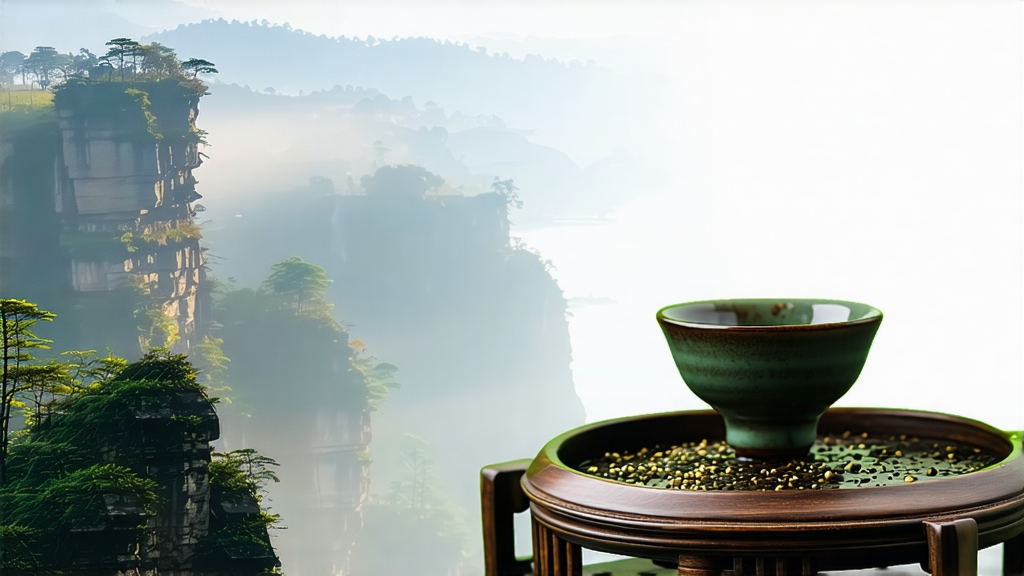
High in the mist-wrapped Wuyi Mountains of northern Fujian, narrow plank paths are still bolted to sheer cliffs so that tea pickers can reach the mother bushes of Da Hong Pao—Big Red Robe—the most mythic name in the oolong universe. Legend says that a Ming-dynasty scholar, on his way to the capital, fell ill at the mountain’s foot; monks from Jiulongke Temple steeped leaves plucked from six ancient bushes that clung to the rock face, restored the young man to health, and sent him off with the remaining tea. He placed first in the imperial examinations and returned in crimson official robes to thank the bushes, draping his robe over them as a mark of gratitude. Whether or not the tale is embroidery, it captures the reverence the Chinese have long felt for a tea whose deep mineral complexity seems to distill the very bones of the mountain.
Da Hong Pao belongs to the “rock oolong” or yancha family, a subgroup of Minbei (northern Fujian) oolongs grown in the 60-kilometre-long Wuyi scenic reserve. Within yancha, Da Hong Pao is not a single cultivar but a collective name that now spans three distinct tiers. The rarest is “Mother Tree Da Hong Pao,” harvested only from the original six bushes planted in the cliffs of Nine-Dragon Gorge. Since 2006 the Chinese government has forbidden any further picking to protect the 350-year-old plants, so the tiny hoard of pre-ban leaf has become a cultural relic rather than a beverage; a mere twenty grams once fetched over US $30,000 at auction. The second tier, “Purebred Da Hong Pao,” comes from cuttings of the mother trees propagated since the 1980s under the code-name Qidan (“strange scarlet”). These gardens occupy the same terroir—weathered tuff, granite scree, and narrow bands of humus flushed by mineral springs—giving the leaf its signature “rock rhyme” (yanyun), a lingering, almost electric sensation of wet stone and cool mint. Finally, “Commercial Da Hong Pao” blends several Wuyi cultivars—most often Rougui for spice, Shui Xian for orchid depth, and a smaller percentage of Qidan—to recreate the mother tree profile at an accessible price. A well-balanced blend can still deliver the cocoa-laced aroma and flinty finish that first enthralled emperors.
Crafting Da Hong Pao is a month-long choreography of wilting, bruising, oxidizing, roasting, and resting that the locals summarize in four characters: liang, yao, zuo, huo—“cooling, shaking, shaping, firing.” Picking begins at dawn in late April when the standard “open-face” leaf is reached—three or four half-mature leaves with a pronounced central spine. The pluck is spread on bamboo trays and withered in the late-morning sun for twenty minutes, just long enough to soften cell walls; trays are then racked inside the cottage where mountain breezes continue the dehydration for two hours. Next comes yaoqing, the signature “rocking” step: trays are stacked and shaken every half-hour so that the edges of the leaves bruise against one another, initiating oxidation along the serrated rims while the centre stays green. After six rounds of shaking and a further six hours of rest, the leaf emits a penetrating scent of peach and toasted almond; at this point the tea master must decide—by scent alone—when oxidation has reached 40–50 %, the narrow band that gives yancha its amber-red cup without sacrificing floral lift.
Once the oxidation window is hit, the leaf is tumble-pan-fired at 240 °C for seven minutes to arrest enzymes, then rolled and compressed in a heated sack cloth to shape the familiar long, ribbon-like strip. The crucial act, however, is the charcoal roast that follows. Traditionally the tea is loaded into rattan baskets lined with horse-hair paper and placed over a pit of glowing lychee-wood embers that hold a steady 80 °C for eight hours. The roast is repeated two or even three times over the next three months, with thirty-day “resting” intervals between each pass so that residual moisture migrates outward. The goal is to drive the tea to a final moisture of 3 % while caramelizing sugars and pyrolyzing amino acids into the nutty, incense-like bouquet that connoisseurs call “honey-rock.” Over-roast and you bury the floral notes; under